中石油职称俄语考试教材
- 格式:pdf
- 大小:892.83 KB
- 文档页数:50
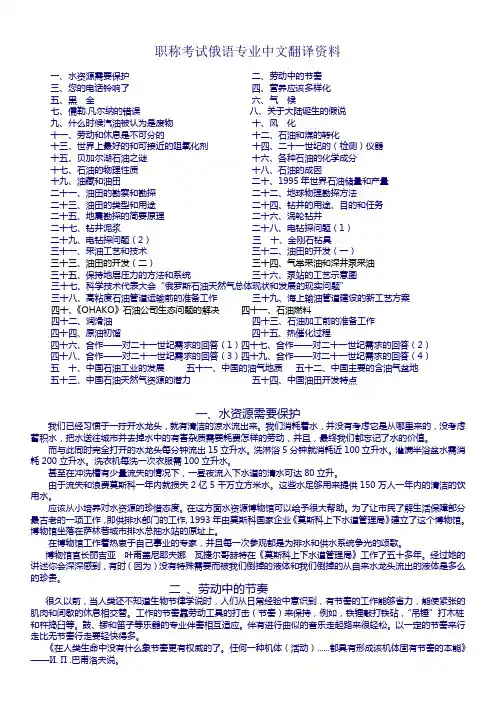
职称考试俄语专业中文翻译资料一、水资源需要保护二、劳动中的节奏三、您的电话铃响了四、营养应该多样化五、黑金六、气候七、儒勒.凡尔纳的错误八、关于大陆诞生的假说九、什么时候汽油被认为是废物十、风化十一、劳动和休息是不可分的十二、石油和煤的转化十三、世界上最好的和可接近的阻氧化剂十四、二十一世纪的(检测)仪器十五、贝加尔湖石油之谜十六、各种石油的化学成分十七、石油的物理性质十八、石油的成因十九、油藏和油田二十、1995年世界石油储量和产量二十一、油田的勘察和勘探二十二、地球物理勘探方法二十三、油田的类型和用途二十四、钻井的用途、目的和任务二十五、地震勘探的简要原理二十六、涡轮钻井二十七、钻井泥浆二十八、电钻探问题(1)二十九、电钻探问题(2)三十、金刚石钻具三十一、采油工艺和技术三十二、油田的开发(一)三十三、油田的开发(二)三十四、气举采油和深井泵采油三十五、保持地层压力的方法和系统三十六、泵站的工艺示意图三十七、科学技术代表大会“俄罗斯石油天然气总体现状和发展的现实问题”三十八、高粘度石油管道运输前的准备工作三十九、海上输油管道建设的新工艺方案四十、《ОНАКО》石油公司生态问题的解决四十一、石油燃料四十二、润滑油四十三、石油加工前的准备工作四十四、原油初馏四十五、热催化过程四十六、合作——对二十一世纪需求的回答(1)四十七、合作——对二十一世纪需求的回答(2)四十八、合作——对二十一世纪需求的回答(3)四十九、合作——对二十一世纪需求的回答(4)五十、中国石油工业的发展五十一、中国的油气地质五十二、中国主要的含油气盆地五十三、中国石油天然气资源的潜力五十四、中国油田开发特点一、水资源需要保护我们已经习惯于一拧开水龙头,就有清洁的凉水流出来。
我们消耗着水,并没有考虑它是从哪里来的,没考虑蓄积水,把水送往城市并去掉水中的有害杂质需要耗费怎样的劳动,并且,最终我们都忘记了水的价值。
而与此同时完全打开的水龙头每分钟流出15立升水。
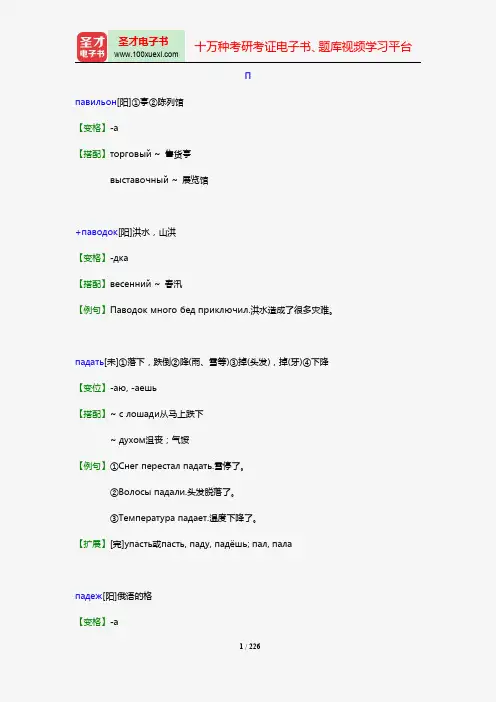
Ппавильон[阳]①亭②陈列馆【变格】-а【搭配】торговый~售货亭выставочный~展览馆+паводок[阳]洪水,山洪【变格】-дка【搭配】весенний~春汛【例句】Паводокмногобедприключил.洪水造成了很多灾难。
падать[未]①落下,跌倒②降(雨、雪等)③掉(头发),掉(牙)④下降【变位】-аю,-аешь【搭配】~слошади从马上跌下~духом沮丧;气馁【例句】①Снегпересталпадать.雪停了。
②Волосыпадали.头发脱落了。
③Температурападает.温度下降了。
【扩展】[完]упасть或пасть,паду,падёшь;пал,палападеж[阳]俄语的格【变格】-ападение[中]①下落②道德的堕落【变格】-я【搭配】~тела自由落体~нравов习俗的败坏+пай[阳]股份【变格】-я【搭配】напаяхскем合伙;合股,集资,凑钱【例句】Согласилисьнатом,чтокаждыйвнесётодинаковыйпай.大家谈妥每人加入同样股份。
*пакет[阳]①纸包,一包②<口语>纸袋,塑料袋(装食品、什物、邮件等所用)③一封公文,一封公函④一组,一串,一系列,一揽子(互相关联的问题、情况、论点等)【变格】-а【搭配】завернутькнигивдва~а把书包成两包~длябелья包装内衣的袋子вскрыть~拆开一封公文~досок一梱木板【例句】①Вампринеслипакетизминистерства.从部里给您送来一封公文。
②Пакетраскрылся.纸包拆开了。
палата[阴]①病房,病室②某些国家的议院【变格】-ы【搭配】больничная~病房обходить~ы查(病)房верхняя~上议院нижняя~下议院*палатка[阴]帐篷【变格】-и,复二-ток【搭配】лагерная~野营帐篷,露营帐篷походная~行军帐篷палец[阳]手指,脚趾【变格】-льца【搭配】пальцынаногах脚趾【扩展】каксвойпятьпальцевзнатького-что对……了如指掌сквозьпальцысмотретьнакого-что视而不见,装不知道палка[阴]棍,棒【变格】-и,复二-лок【搭配】опиратьсяна~у拄着拐杖пальто[中,不变]大衣,外衣【搭配】ходитьв~穿着大衣памятник[阳]①纪念碑②古迹,文物【变格】-а【接格】кому【搭配】~Пушкину普希金纪念碑памятный[形]①永志不忘的;难忘的;值得记忆的,可纪念的②备忘的,记事的;(作为)纪念的【变化】-ая,-ое【搭配】~деньмоейжизни我一生中难忘的日子~аякнижка记事手册память[阴]①记忆力,记性②纪念,回忆③(计算机)存储器【变格】-и【搭配】говоритьна~凭记性说оставитьхорошую~留下好印象внешняя~外存+панда[阴]小熊猫【变格】-ы【搭配】малаяпанда小熊猫【例句】Панда-большаяредкостьвмире.熊猫是稀世之珍。
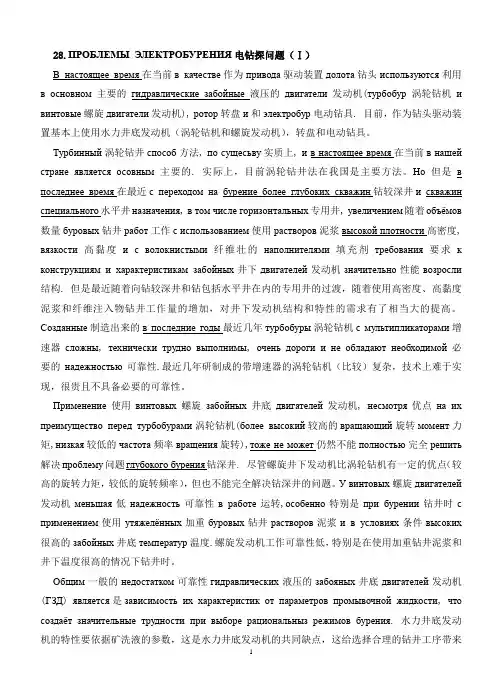
28.ПРОБЛЕМЫЭЛЕКТРОБУРЕНИЯ电钻探问题(Ⅰ)Внастоящеевремя在当前вкачестве作为привода驱动装置долота钻头используются利用восновном主要的гидравлическиезабойные液压的двигатели发动机(турбобур涡轮钻机ивинтовые螺旋двигатели发动机), ротор转盘и和электробур电动钻具. 目前,作为钻头驱动装置基本上使用水力井底发动机(涡轮钻机和螺旋发动机),转盘和电动钻具。
Турбинный涡轮钻井способ方法, посущесьву实质上, ивнастоящеевремя在当前внашейстранеявляетсяосовным主要的. 实际上,目前涡轮钻井法在我国是主要方法。
Но但是впоследнеевремя在最近спереходомнабурениеболееглубокихскважин钻较深井искважинспециального水平井назначения, втомчислегоризонтальных专用井, увеличением随着объёмов数量буровых钻井работ工作сиспользованием使用растворов泥浆высокойплотности高密度, вязкости高黏度исволокнистыми纤维壮的наполнителями填充剂требования要求кконструкциямихарактеристикамзабойных井下двигателей发动机значительно性能возросли结构. 但是最近随着向钻较深井和钻包括水平井在内的专用井的过渡,随着使用高密度、高黏度泥浆和纤维注入物钻井工作量的增加,对井下发动机结构和特性的需求有了相当大的提高。
Созданные制造出来的впоследниегоды最近几年турбобуры涡轮钻机смультипликаторами增速器сложны, техническитрудновыполнимы, оченьдорогиинеобладаютнеобходимой必要的надежностью可靠性.最近几年研制成的带增速器的涡轮钻机(比较)复杂,技术上难于实现,很贵且不具备必要的可靠性。
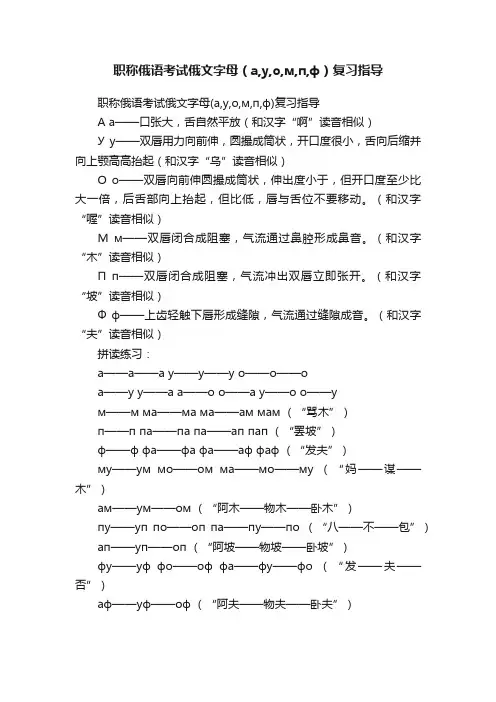
职称俄语考试俄文字母(а,у,о,м,п,ф)复习指导
职称俄语考试俄文字母(а,у,о,м,п,ф)复习指导
А а——口张大,舌自然平放(和汉字“啊”读音相似)
У у——双唇用力向前伸,圆撮成筒状,开口度很小,舌向后缩并向上颚高高抬起(和汉字“乌”读音相似)
О о——双唇向前伸圆撮成筒状,伸出度小于,但开口度至少比大一倍,后舌部向上抬起,但比低,唇与舌位不要移动。
(和汉字“喔”读音相似)
М м——双唇闭合成阻塞,气流通过鼻腔形成鼻音。
(和汉字“木”读音相似)
П п——双唇闭合成阻塞,气流冲出双唇立即张开。
(和汉字“坡”读音相似)
Ф ф——上齿轻触下唇形成缝隙,气流通过缝隙成音。
(和汉字“夫”读音相似)
拼读练习:
а——а——а у——у——у о——о——о
а——у у——а а——о о——а у——о о——у
м——м ма——ма ма——ам мам(“骂木”)
п——п па——па па——ап пап (“罢坡”)
ф——ф фа——фа фа——аф фаф (“发夫”)
му——ум мо——ом ма——мо——му (“妈——谋——木”)
ам——ум——ом (“阿木——物木——卧木”)
пу——уп по——оп па——пу——по (“八——不——包”)ап——уп——оп (“阿坡——物坡——卧坡”)
фу——уф фо——оф фа——фу——фо (“发——夫——否”)
аф——уф——оф (“阿夫——物夫——卧夫”)。

2014年硕士研究生入学考试大纲
考试科目名称:基础俄语考试时间:180分钟,满分:150分一、考试要求:
语法:1.熟练掌握全部基本词汇知识和基本句法知识。
2.初步了解俄语语法体系,概念清楚。
词汇:1.熟练掌握4000-4500个单词,其中积极掌握3000-3500个单词。
2.能够用俄语解释俄文词汇或句子。
二、考试内容:
1.语法的考核
(1)词法的考核
(2)句法的考核
(3)语法术语的俄文名称
2.词汇的考核
(1)掌握俄语基础词汇的用法,并能造句
(2)写出基础词汇的同义词和反义词
(3)用俄文撰写800-1000词汇的短文
三、参考书目
大学俄语东方(1-8),丁树杞,外语教学与研究出版社,2005,第14版。
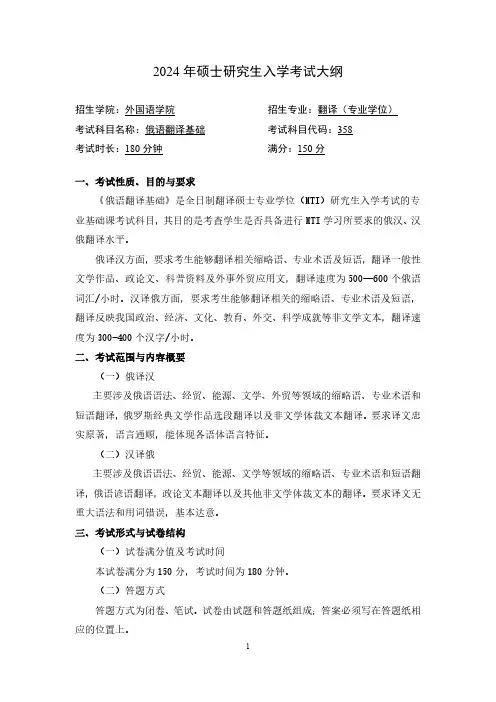
2024年硕士研究生入学考试大纲招生学院:外国语学院招生专业:翻译(专业学位)考试科目名称:俄语翻译基础考试科目代码:358考试时长:180分钟满分:150分一、考试性质、目的与要求《俄语翻译基础》是全日制翻译硕士专业学位(MTI)研究生入学考试的专业基础课考试科目,其目的是考查学生是否具备进行MTI学习所要求的俄汉、汉俄翻译水平。
俄译汉方面,要求考生能够翻译相关缩略语、专业术语及短语,翻译一般性文学作品、政论文、科普资料及外事外贸应用文,翻译速度为500—600个俄语词汇/小时。
汉译俄方面,要求考生能够翻译相关的缩略语、专业术语及短语,翻译反映我国政治、经济、文化、教育、外交、科学成就等非文学文本,翻译速度为300-400个汉字/小时。
二、考试范围与内容概要(一)俄译汉主要涉及俄语语法、经贸、能源、文学、外贸等领域的缩略语、专业术语和短语翻译,俄罗斯经典文学作品选段翻译以及非文学体裁文本翻译。
要求译文忠实原著,语言通顺,能体现各语体语言特征。
(二)汉译俄主要涉及俄语语法、经贸、能源、文学等领域的缩略语、专业术语和短语翻译,俄语谚语翻译,政论文本翻译以及其他非文学体裁文本的翻译。
要求译文无重大语法和用词错误,基本达意。
三、考试形式与试卷结构(一)试卷满分值及考试时间本试卷满分为150分,考试时间为180分钟。
(二)答题方式答题方式为闭卷、笔试。
试卷由试题和答题纸组成;答案必须写在答题纸相应的位置上。
(三)试卷内容结构本考试包括四个部分:缩略语及短语俄译汉(15分)、短语及谚语汉译俄(15分)、短文俄译汉(60分)、短文汉译俄(60分)。
(四)试卷题型结构序号考试内容题型及题量分值考试时长(分钟)1缩略语及短语俄译汉15道小题(每题1分)15202短语及谚语汉译俄15道小题(每题1分)15203短文俄译汉1篇非文学文本翻译(250个左右单词)3035 1篇文学文本翻译(250个左右单词)30354短文汉译俄1篇非文学文本翻译(200个左右单词)3035 1篇非文学文本翻译(200个左右单词)3035合计150180四、主要参考书目1.史铁强主编.大学俄语(东方)(1-8).北京:外语教学与研究出版社,2010.2.孙大满、姜训禄等.石油工业俄语阅读与翻译.青岛:中国石油大学出版社,2005.3.孙淑芳主编.经贸俄语(第2版).上海:上海外语教育出版社,2021.4.张建华、任光宣、余一中.俄罗斯文学选集,外语教学与研究出版社,2001.五、样题第一部分:将下列缩略语和短语译为汉语。
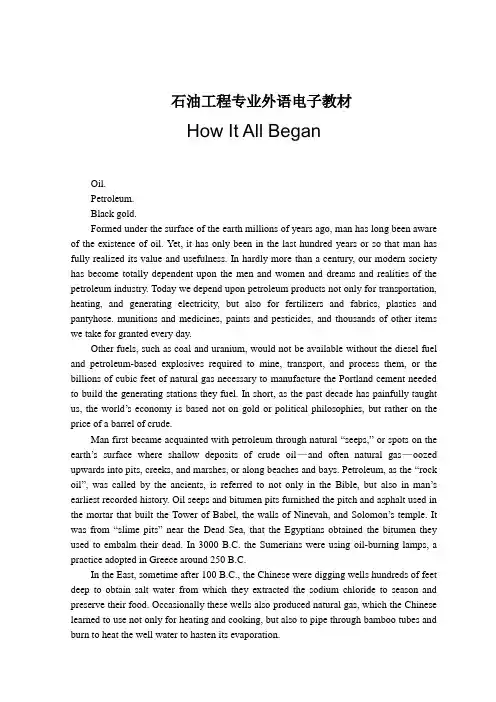
石油工程专业外语电子教材How It All BeganOil.Petroleum.Black gold.Formed under the surface of the earth millions of years ago, man has long been aware of the existence of oil. Yet, it has only been in the last hundred years or so that man has fully realized its value and usefulness. In hardly more than a century, our modern society has become totally dependent upon the men and women and dreams and realities of the petroleum industry. Today we depend upon petroleum products not only for transportation, heating, and generating electricity, but also for fertilizers and fabrics, plastics and pantyhose. munitions and medicines, paints and pesticides, and thousands of other items we take for granted every day.Other fuels, such as coal and uranium, would not be available without the diesel fuel and petroleum-based explosives required to mine, transport, and process them, or the billions of cubic feet of natural gas necessary to manufacture the Portland cement needed to build the generating stations they fuel. In short, as the past decade has painfully taught us, the world’s economy is based not on gold or political philosophies, but rather on the price of a barrel of crude.Man first became acquainted with petroleum through natural “seeps,” or spots on the earth’s surface where shallow deposits of crude oil—and often natural gas—oozed upwards into pits, creeks, and marshes, or along beaches and bays. Petroleum, as the “rock oil”, was called by the ancients, is referred to not only in the Bible, but also in man’s earliest recorded history. Oil seeps and bitumen pits furnished the pitch and asphalt used in the mortar that built the Tower of Babel, the walls of Ninevah, and Solomon’s temple. It was from “slime pits”near the Dead Sea, that the Egyptians obtained the bitumen they used to embalm their dead. In 3000 B.C. the Sumerians were using oil-burning lamps, a practice adopted in Greece around 250 B.C.In the East, sometime after 100 B.C., the Chinese were digging wells hundreds of feet deep to obtain salt water from which they extracted the sodium chloride to season and preserve their food. Occasionally these wells also produced natural gas, which the Chinese learned to use not only for heating and cooking, but also to pipe through bamboo tubes and burn to heat the well water to hasten its evaporation.By 615 A.D., the Japanese were digging wells nearly 1,000 ft deep in attempts to obtain “burning water,” a practice which was also occurring in Burma and India at about the same time. And, along the banks of the Caspian Sea, men were digging shallow wells by hand to obtain oil to light their lamps.As man found more and more of this strange substance, he slowly began to learn that it could be used in many ways. In 671 A.D., Kallinikos of Byzantium invented a primitive missile which he called Greek Fire. which carried an incendiary payload composed of petroleum, sulfur. resin, and rock salt, which the Greeks used against their enemies, the Arabs, during the siege of Constantinople. The Greeks also used petroleum in war at sea, pouring it on the water and igniting it, a fearsome weapon against wooden ships. Even earlier, the legionnaires of ancient Rome won a battle by setting oil-soaked pigs aflame and driving them into the ranks of the approaching enemy.Gradually, the use of petroleum began to spread across parts of Asia and Europe. But, in order for any new industry to come about, three factors must be present: a widely demonstrated need for the product provided, a reliable and economical source of supply, and an established market price that would guarantee a return on investment sufficient to overcome the risks inherent in any new venture. Thus, the time was not yet right for the birth of the worldwide petroleum industry, and it would not be until the Europeans ventured west that the sleeping giant would begin to awaken.1.1 The New WorldWhen the first explorers ventured into the New World, they found petroleum marshes as well as huge asphalt pools in Trinidad, Venezuela, and later, in California. As more and more adventurers made the long voyage across the Atlantic, they learned to come to these places, beach their sea-weary ships and caulk their leaks with boiled-down petroleum residues. Not only did this seal the hulls, it also protected them against teredos, small, worm-like marine mollusks that inhabit tropical waters and bore into wooden ships, destroying them. In the years to come, this practice of ship coating would grow into an industry of its own and create one of the first economic demands for petroleum products.1.1.1 Latin AmericaThe Indians in what is now Mexico, called this tarry substance Chapapote, while in Venezuela and other parts of South America it was called Mene. The pre-Colombian peoples used chapapote or mene—which had worked its way to the earth’s surface—as medicine in the form of liniments and ointments, to coat footwear, boats, and roofing, as glue, for illumination. and as incense. In 1579, Commander Melcor de Alfaro Santa Cruzhad written home to Spain describing the many uses of chapapote in Mexico, which included toothpaste and chewing gum. However. Venezuela may have become the world’s first petroleum exporting country when in 1539, several barrels of mene were shipped to Spain, apparently in response to an urgent request for a “miracle drug” to cure the painful gout afflicting Emperor Charles Ⅴ. Rumors having reached the royal ears of the great medicinal powers attributed by the Indians to a mysterious substance found around Lake Maricaibo. Thus the origins of today’s petroleum industry are closely entwined with the history of Latin America, and many Latin nations have contributed to the industry that has changed the world.1.1.2 North AmericaLater, as Europeans penetrated the northern portion of the hemisphere, they found that the Indians from California to what is now Pennsylvania and Canada were also familiar with this strange black substance that came from within the earth, and had developed many practical uses for it. In southern California, they applied asphalt to baskets or cloth to make them waterproof. These baskets were used to carry water since they were not only lighter than pottery, but unbreakable as well. Asphalt was also used to caulk their boats and waterproof their roofs. In 1788, Peter Pond, exploring western Canada in what is now Alberta, reported that the Cree Indians were using tar from the Athabasca River to caulk their canoes and also as medicine.Today, one of the most widely used skin ointments in the world is known in English as “Indian Petrolatum,”or, “petroleum jelly,”a scientific name derived from the Greek which obscures its American Indian invention, in making this nearly colorless gelatinous material of olefin hydrocarbons and methane, the Indians found one of the first practical uses of petroleum. They applied it to human and animal skins to protect wounds, stimulate healing, and to keep the skin moist. They also used it to lubricate the moving parts of tools. Today, petroleum jelly has found its way to the most remote parts of the earth, including the Sahara where nomadic tribesmen smear it on their skin to protect themselves from the relentless sun, dry wind, and pounding sand.The Indians to Pennsylvania used a number of open pits as oil wells, a fact noted by the white settlers of the Quaker State who, in the nineteenth century, not only launched the American petroleum industry from this spot. but in so doing, created the impetus that would move the world into the petroleum society.As the settlers began to move westward into the interior of this vast land, the need was not for oil, but, as had been the case in other parts of the world, for salt, so they could preserve their food for the long winter months. Those living in the Ohio Valley and the westward slope of the Alleghenies found they could drill wells through the rock down into subsurface brine deposits. When the brine was brought to the surface, it was boiled downand the resulting salt used to cure their meat.But some of these crude, hand-drilled wells produced oil as well as salt. Since the oil contaminated the salt, it was considered a nuisance by the colonists who either drained it into nearby creeks or into sump pits where it was burned. However, plantation owner George Washington considered his Virginia estate’s “bitumen spring”to be of value. Harking back to the days of the Indian healers, a few entrepreneurs bottled this residue and sold it as a widely acclaimed “cure-all” through itinerant wagon shows and local druggists.1.1.3 The Search for LightSamuel M. Kier, a Pittsburgh druggist who owned some brine wells near Tarentum, Pennsylvania, was one of these. In addition to salt, Kier’s wells also produced much petroleum. From this “useless”by-product. Kier bottled his oil, labeled it “Pennsylvania Rock Oil,” and advertised it far and wide. But, it failed to find a ready market. Undaunted, Kier then devised a crude still to convert his petroleum into a lamp oil. His “rock oil”burned, but it had a bad odor, and produced a heavy, black smoke. Although Kier was not successful, suddenly the first birth pains of the oil industry were felt because man began to realize there was a widespread need for petroleum.By mid-nineteenth century, the idea of popular education had spread widely; more and more people could read and write. And, there was more to read since this was also a great period of growth for the newly popular newspapers and magazines which were now beginning to be published for the masses instead of for an elite few. But for the most part, the world was still largely an agrarian society. On farms, and in the cities which were becoming industrialized. people worked a minimum of twelve hours a day, or from dawn to dark. This made reading a leisure time activity, which had to be done at night, after the day’s labors were completed. Therefore, in order to read, people needed light. Light was also needed by the new factories of the Industrial Age if they were to be able to operate during the short and dark winter days and survive economically. Many used tallow candles which were both expensive and ineffective, or, sperm oil from whales, which though relatively clean burning, was becoming more and more expensive because even then the great herds of whales had been hunted to the point of extinction.In both America and Europe a search was on for a source of light that could be manufactured to sell at a reasonable price, burn cleanly, and provide effective illumination.In a few large cities, plants had been built to process artificial gas from coal or to furnish natural gas from wells located in the towns themselves. Gas lights illuminated the streets at night, and indoors “jets”—thousands of times brighter than candies—not only brightened homes, but also made the forerunners of the modem factory possible for the first time. Gaslight quickly became enormously popular, but the piping was crude and expensive to install, which meant that gas was available only in metropolitan areas. So thesearch, including attempts to produce a light source from petroleum, continued.In 1849 ,James Young, a Scotsman, obtained a patent for processing cannel coal (or more likely, cannel shale which is prevalent in Scotland), which he distilled into what he called coal oil. It became popular almost immediately, and the world’s first refining industry sprang up in Britain as Young issued licenses on his patent for the production of coal oil in both Great Britain and the United States.1.1.4 CanadaA brilliant and innovative Canadian, was responsible for the next step in the birthing. Abraham Gesner, a medical doctor who was also an amateur geologist and self-taught chemist from Nova Scotia, began experimenting in the 1840s with producing lamp oils from both asphalt and coal. Using a process similar to Young’s, he became the first in North America to distill a hydrocarbon into lamp fuel. In 1853, he moved his operation to New York and began producing coal oil. The following year he introduced a new product called “Kerosene,” from the Greek words for oil and wax. Even though coal oil and the early kerosene were smelly, smoked badly, and cost dearly, they immediately became far more popular than whale oil, which had risen in price to $2.50 per gallon, which placed it far beyond the reach of most consumers. Gesner began to issue licenses under his American patent, and by 1860, there were more than 70 plants in the United States producing an estimated 23,000 gals of coal oil per year from natural asphalts, soft coal, and shale.All of this would last only a few short years however, for it was to be kerosine refined from petroleum, not coal oil, that would light the world. Up until the mid-1850s all crude oil had either been skimmed from seeps or produced as an unwanted by-product of brine wells, and was considered by many to be good only as a medicine show novelty. But two brothers in a tiny village in Canada West, as Ontario was called in 1854, would change all that and in so doing, change the world. Henry and Charles Nelson Tripp of Enniskillen Township on the north shore of Lake Ontario, a metropolis inhabited by 37 settlers. 34 cows. and 16 hogs, founded the world’s first incorporated oil company, International Mining and Manufacturing. Their interests were not in lamp oil, but in possible industrial uses for the black, tar-like substance from gum beds located on their property. In 1850 a chemist with the Canadian Geological Survey had pointed out that the gum had possible commercial use as paving material, a sealant for ship bottoms, and as raw material for the manufacture of illuminating gas. By 1854 they were digging the bitumen by hand, and boiling it down in open cast iron kettles. Their major trust was to sell their product for paving and for marine use as ship coating. Even though the Hamilton Gas Company reported that gas made from the bitumen produced far more illumination than the gas produced from coal, the Tripps ignored this market and by 1856 their company failed andwas forced to sell its gum beds. It was to the buyer of their 600 ac of potential oil land that fame as the founder of the North American oil industry would come.James Miller Williams was a carriage maker from Hamilton, Ontario. In 1857 he set up a simple refinery on Black Creek and set out to drill for oil, correctly assuming that if he penetrated below the surface of the asphalt beds he would find more oil. His first well was abandoned after the pipe broke off at 27 ft, but in 1858 he successfully produced oil from a depth of 49 ft. Whereas the Tripps had mined the bitumen from its surface beds, Williams began pumping crude oil from a reservoir beneath them, which he then refined into lamp oil. In I860 he reincorporated as the Canadian Oil Company. This was North America’s first integrated oil company, since its activities included exploration, production, refining, and marketing. That same year, nearly 100 wells were drilled in the Oil Springs area with the successful ones producing 12 to 23 B/D (barrels per day). Then, on January 16, I862, the greatest gusher the world had ever seen blew in at Oil Springs. Spouting crude more than 20 ft into the air, it flowed at an astonishing 2.000 B/D. Refineries quickly sprang up across Ontario, but almost as quickly, the momentum of the growing industry flowed south across the border (Figure 1-1).Figure 1-1 James Miller Williams [courtesy The Oil Museum of Canada]1.2 The United StatesIn 1857, Col. A. C. Ferris, a major supplier of lamp oil, saw samples of Samuel Kiers rock oil in use. He purchased some and ran it through his processing plant. It producedsuch a superior lighting oil that he sent agents far and wide buying crude for $20/bbl, a price the world would not see again for more than a century. Some of this oil he purchased from Williams in Ontario, although most of his supply came haphazardly from brine wells, oil springs, or oil seeps. Suddenly, the pieces of the puzzle began to come together, there was a growing need for the product, a firm market price had been established, so all that remained was the development of a reliable supply of raw material in quantity, in this case, crude oil.1.2.1 The Birth of the IndustryJames Miller Williams may well have been the father of the modern oil industry, but history, fickle as always, has chosen to award that honor to an American, Col. Edwin Drake(Figure 1-2). A former railway conductor, the “colonel” was an affectation adopted to impress the towns-people of Oil Creek. Pennsylvania, where Drake, as representative of the Pennsylvania Rock Oil Company, spent three unsuccessful years trying to skim oil in marketable quantities from the same springs the Indians had used years before. When the company failed, Drake organized the Seneca Oil Company to try again. This time he looked at the brine wells that had been drilled at nearby Tarantum and made the momentous decision to try to obtain oil in quantity by drilling for it —a decision that brought him ridicule and derision from the local population.Figure 1-2 Colonel Edwin Drake [courtesy The Drake Well Museum]He assembled a steam-powered cable-tool drilling rig much the same as the ones used by the salt water drillers and began operations. That he was successful was due in no smallpart to the skill and dedication of his driller, William A, “Uncle Billy” Smith, a blacksmith and experienced brine well driller. After penetrating 30 ft of rock. Drake struck oil at a total depth of 69 1/2 ft. The well was not a gusher —the oil had to be pumped to the surface, but it was the first “oil-well”in the United States and the lamp oil producers quickly flocked to the site to buy Drake’s oil for $20/bbl. That day, August 27, I859, is noted as the birthday of the oil industry, for Drake had proves that it was possible to obtain oil in quantity by drilling for it through rock. At last the combination had come together: the need for oil, an established market and price, and a method of obtaining oil in quantity (Figure 1-3).Figure 1-3 Drake Well 1866 [courtesy The Drake Well Museum]Almost overnight Titusville and the Oil Creek area became the World’s first oil boom town as buyers, would-be producers, and lessors swarmed to the area, giving western Pennsylvania the title “Cradle of the Oil industry.” Although many men in many countries around the world were seeking oil, Drake just happened to be the first to find it in quantity by drilling through rock. and he was far more fortunate in his selection of a site than anyone at the time realized(Figure 1-4).By pure chance the Drake well was located in an area where the pay sands were close to the earth’s surface and could easily be reached with the primitive equipment at hand. In fact, the Oil Creek field was the shallowest and most productive ever discovered. This permitted large-scale production in a short time. The area was also accessible to the available transportation facilities. In addition to the railroad, Oil City, south of Titusville, was located on the banks of the Allegheny River which joined both the Monongahela andthe Ohio at Pittsburgh. Thus, needed supplies could be brought in and the oil shipped out to the markets of the rapidly industrializing north. As a final blessing, the oil was of high gravity and sulfur-free. In fact, for decades to come Pennsylvania-grade crude was the world’s standard against which all other oils were measured. It could easily be refined into a high-quality kerosene with the unsophisticated refining processes that were then in use. Also, since it had a paraffin base, it could easily be made into lubricants with the available technology. If Drake’s oil had been heavy, sour crude with a high sulfur content, the pioneer refiners would not have known what to do with it and the birth of the industry would have been delayed.Figure 1-4 Oil Creek in early 1860s[courtesy The Drake Well Museum]1.2.2 New Uses for PetroleumDozens of rigs soon covered the Pennsylvania landscape. Oil was produced so rapidly and in such great quantities that the existing storage facilities soon proved woefully inadequate and thousands of barrels spilled out on the ground and into rivers and creeks. The price rapidly began to drop, but despite the initial overproduction and a lowered price structure, the infant industry continued to grow and prosper as more and more uses were discovered for petroleum. At first the only needs were for lamp oil and lubricants, anything else that came out of the barrel including naphtha, benzene, and gasoline, was considered dangerous waste which was either burned or dumped into the nearest creek.The new industry was still only a two-year old infant when the horror of the Civil War burst across America, unleashing a new technological age. No longer were ships powered by sail alone—steam engines propelled supplies across the Atlantic, and the first iron warships and steamboats up and down the mighty rivers. Their engines, as well as the machinery in the factories that turned out cannons, repeating firearms, telegraph wire,barbed wire, and tents and clothing all needed lubrication, and lamp oil was needed to keep them working through the night, and to illuminate the field hospitals and headquarters tents.1.2.3 The Move WestwardBy the time the last Confederate general, Stand Watie, a Cherokee Indian, surrendered in Texas, half the nation lay in ruins. All of the railroads in the south, together with most of the port and manufacturing facilities, had been destroyed. A massive job of rebuilding was needed, one that called for more and more petroleum products. No sooner than this was underway, than men began to turn their ambitions westward. The War had given them the tools: barbed wire, steamboats, railroads, and repeating firearms, with which they could finally conquer the American West. The need for oil had turned into a never-ending demand.Not only was there a great demand for oil, there were great profits to be made in the ever-growing industry, a fact which did not escape the notice of John D. Rockefeller, who, in 1870, founded the Standard Oil Company. There were also great profits to be made by those who found new sources of oil to meet these increasing needs. This was still an era when little was known about reservoir mechanics, and there were fears that the Pennsylvania fields were becoming totally depleted. So as Americans moved westward, so did the search for oil. New fields were discovered in the Ohio Valley and in Illinois and Kentucky, although much of this proved to be heavier and more sour than the Pennsylvania grade crude. The search continued however, even into Wyoming, although these early wildcatters could not know that an American and two Germans, Thomas A. Edison, Gottlieb Daimler, and Carl Benz were on the verge of perfecting inventions that would change the oil industry—and the world—forever.1.2.4 Winners and LosersIn early part of the nineteenth century the Cherokee Indians in the southeastern United Stales became known as one of the Five “Civilized” Tribes because they had adapted so well to the white man’s society. Many owned large estates and lived in fine homes whose furnishings often included extensive libraries. They published their own newspaper in the Cherokee language, and they sent their children to universities in the north and in Europe to be educated. Suddenly however, disaster struck. Gold was discovered on the Cherokee lands in northern Georgia. Overnight, greedy gold seekers evicted them from their home and confiscated their lands. Those who escaped the volunteer “militia”were driven westward at bayonet point, and hundreds died along the shameful Trail of Tears. Eventually, the survivors were resettled in the vast Cherokee Nation in Indian Territory. Very few, if any at all, ever got to enjoy any of the mineral wealth of their ancestral home.Removal, an integral part of the “taming of the west,” was the Government’s policy of moving as many Indians as possible onto reservations, many of which were located in Indian Territory. A few years after the Cherokees, it came the Osages’turn to go. They pointed out to the Government that there was no land left that was not already assigned to a tribe. The terse response was, “Find some land, buy it, and go—or else.” What they found was 1.8 million ac of hilly, rocky scrub, little suited for farming or much else, at the northern end of the Cherokee Nation. The Cherokees were more than happy to unload it on the hapless Osages for 75$/ac. Happy that is, until the Nellie Johnstone #1 was drilled in 1897.The first producing well in the Territory, it signaled the opening of the vast Oklahoma oil fields and for a time made the Osages the richest per capita nation in the world. But it was during a few hours on the afternoon of January 10, 1901, on a marshy bit of waste land near Beaumont, Texas, that the world was changed forever.1.3 SpindletopSpindletop—to oilmen the name still evokes feelings akin to Columbus first sighting of the New World or Neil Armstrong first setting foot on the moon. For it was on this worthless bit of Texas swamp that the first American gusher blew in with a mighty roar that was heard around the world. For if Drake’s well signaled the birth of the oil industry. Spindletop gave birth to Age of Liquid Fuel, and in so doing changed the lives of everyone on Earth. Now there was no looking back.Spindietop—although that is not the name they would have chosen—was the culmination of the dreams of two highly unlike, but equally colorful oilmen: Captain Anthony Lucas, a transplanted Slav mining engineer, and Patillo “Bud”Higgins, a one-armed Texas Hellraiser turned Sunday School teacher.As a youth, Higgins had lost an arm as the result of a prank. One evening he and a group of companions had tossed a hornet’s nest into a tent where a Baptist revival meeting was taking place. An overly zealous deputy sheriff pursuing the group fired a shot that stuck young Higgins in the arm. The wound became infected and his arm had to be amputated. Higgins was a carousing brawler however, and to him the loss of a limb seemed to mean little. He headed for the timber country where he proceeded to show the other loggers he could outfight, outdrink, and outwork anyone with two arms and fists. His reputation grew until the townspeople dreaded to see him come in out of the woods on Saturday nights. But on one such evening fate stepped in again. He was passing another Baptist tent meeting much like the first one, when he paused for a moment, stayed to listen, and as a result “got religion.”One of the pillars of the church, George W. Carroll, was deeply impressed by Higgins’conversion and offered him a job in his land and real estate business. Higgins accepted, and quickly became a successful and respected member of the community. One day, after a heavy rainstorm, Higgins happened to notice an unusual deposit of red clay that contrasted sharply with the black soil of the area. He had a sample analyzed and found it was the type of clay from which bricks could be made.Sensing a ready market for bricks, Higgins had a group of investors join him in building a kiln. The business showed a profit, but was inefficient, so Higgins went north to study established kiln operations. In Pennsylvania and Ohio he learned the kilns were fired by natural gas and by oil, more stable and efficient fuels than wood or coal. In seeking more information, he learned that many of the geological characteristics that oilmen looked for in their search for petroleum were present in a small mound that rose from the marshes south of Beaumont. When he returned to Texas, he studied the area carefully and became convinced that the mound was sitting above oil—much oil.Figure 1-5 Patillo Higgins [courtesy Amoco Torch]He approached George Carroll with his theory. Carroll agreed to support him, and in 1892 they formed the Gladys City Oil, Gas, and Manufacturing Company. Together with his dream of oil, Higgins had another dream—that of a whole new planned city. One with oil wells of course, but so laid out that there would be orderly growth and beauty as well as industry. For five years, using crude water well equipment, the company sought oil with no success. Finally, Higgins sold his interest to Carroll, and spent three years trying to form。
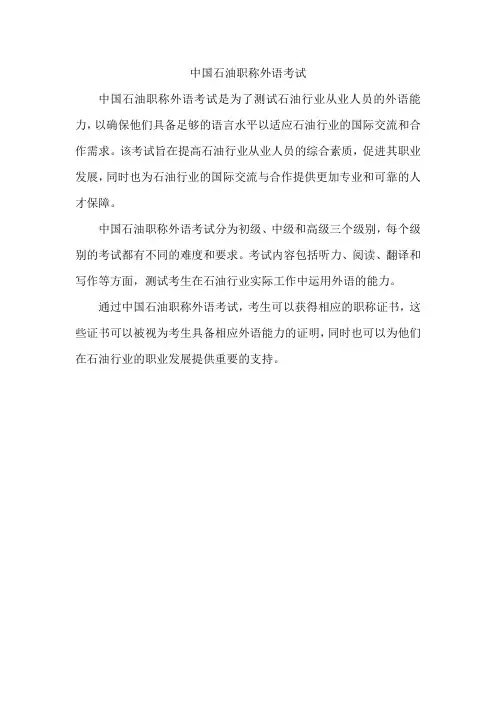
中国石油职称外语考试
中国石油职称外语考试是为了测试石油行业从业人员的外语能力,以确保他们具备足够的语言水平以适应石油行业的国际交流和合作需求。
该考试旨在提高石油行业从业人员的综合素质,促进其职业发展,同时也为石油行业的国际交流与合作提供更加专业和可靠的人才保障。
中国石油职称外语考试分为初级、中级和高级三个级别,每个级别的考试都有不同的难度和要求。
考试内容包括听力、阅读、翻译和写作等方面,测试考生在石油行业实际工作中运用外语的能力。
通过中国石油职称外语考试,考生可以获得相应的职称证书,这些证书可以被视为考生具备相应外语能力的证明,同时也可以为他们在石油行业的职业发展提供重要的支持。
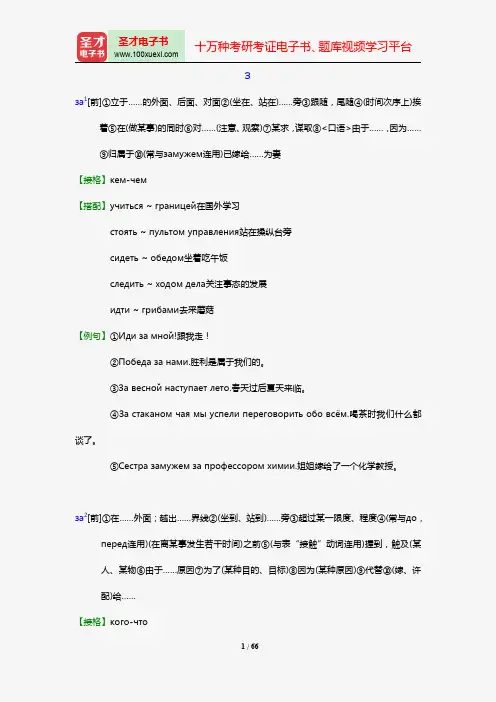
Зза1[前]①立于……的外面、后面、对面②(坐在、站在)……旁③跟随,尾随④(时间次序上)挨着⑤在(做某事)的同时⑥对……(注意、观察)⑦某求,谋取⑧<口语>由于……,因为……⑨归属于⑩(常与замужем连用)已嫁给……为妻【接格】кем-чем【搭配】учиться~границей在国外学习стоять~пультомуправления站在操纵台旁сидеть~обедом坐着吃午饭следить~ходомдела关注事态的发展идти~грибами去采蘑菇【例句】①Идизамной!跟我走!②Победазанами.胜利是属于我们的。
③Завеснойнаступаетлето.春天过后夏天来临。
④Застаканомчаямыуспелипереговоритьобовсём.喝茶时我们什么都谈了。
⑤Сестразамужемзапрофессоромхимии.姐姐嫁给了一个化学教授。
за2[前]①在……外面;越出……界线②(坐到、站到)……旁③超过某一限度、程度④(常与до,перед连用)(在离某事发生若干时间)之前⑤(与表“接触”动词连用)握到,触及(某人、某物⑥由于……原因⑦为了(某种目的、目标)⑧因为(某种原因)⑨代替⑩(嫁、许配)给……【接格】кого-что【搭配】уехать~границу出国работать~него替代他工作критиковатьего~нарушениетишины因喧哗而批评他взятького~руку拉住……的手сесть~стол坐在桌旁выйтизамужзаучителя嫁给老师【例句】①Радзавас.我为您高兴。
②Мороззадвадцатьградусов.冷到零下20度以下。
за3[前]①(用作谓语)同意②(用作名词)拥护(的理由),赞成(之处);长处【搭配】взвеситьвсе~ипротив权衡所有的利弊【例句】Будемголосовать:ктоза,ктопротив?现在进行表决,谁赞成,谁反对?*забастовка[阴]罢工,罢课,罢市【变格】-и,复二-вок【搭配】объявить~у宣布罢工【例句】Забастовкаохватилавсюстрану.罢工席卷全国。
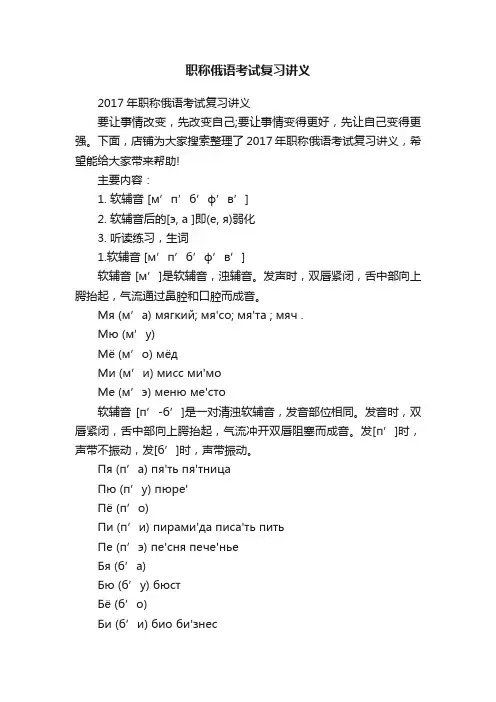
职称俄语考试复习讲义2017年职称俄语考试复习讲义要让事情改变,先改变自己;要让事情变得更好,先让自己变得更强。
下面,店铺为大家搜索整理了2017年职称俄语考试复习讲义,希望能给大家带来帮助!主要内容:1. 软辅音[м’п’б’ф’в’]2. 软辅音后的[э, а ]即(е, я)弱化3. 听读练习,生词1.软辅音[м’п’б’ф’в’]软辅音[м’]是软辅音,浊辅音。
发声时,双唇紧闭,舌中部向上腭抬起,气流通过鼻腔和口腔而成音。
Мя (м’а) мягкий; мя'со; мя'та ; мяч .Мю (м’у)Мё (м’о) мёдМи (м’и) мисс ми'моМе (м’э) меню ме'сто软辅音[п’-б’]是一对清浊软辅音,发音部位相同。
发音时,双唇紧闭,舌中部向上腭抬起,气流冲开双唇阻塞而成音。
发[п’]时,声带不振动,发[б’]时,声带振动。
Пя (п’а) пя'ть пя'тницаПю(п’у) пюре'Пё (п’о)Пи (п’и) пирами'да писа'ть питьПе (п’э) пе'сня пече'ньеБя (б’а)Бю (б’у) бюстБё (б’о)Би (б’и) био би'знесБе (б’э) бе'лка бесе'да软辅音[ф’-в’]是一对清浊软辅音,发音部位相同。
上齿轻触下唇,形成缝隙,舌中部向上腭抬起,气流由缝隙中摩擦而出。
发[ф’]时,声带不振动,发[в’]时,声带振动。
Фя (ф’а)Фю (ф’у)Фё (ф’о)Фи (ф’и) фи'ник фильмФе (ф’э) фенВя (в’а) вязВю (в’у)Вё (в’о)Ви (в’и) ви'рус витами'нВе (в’э) вес весы верх век应注意,ви 的发音不等同于《wei》(维)的音。

Э+эвакуация[阴]后送;疏散;撤回【变格】-и【搭配】~ценностей贵重物品的疏散возвратитьсяиз~и从疏散地回来эвакуировать[完,未]疏散;撤回,后送【变位】-рую,-руешь【接格】кого-что【搭配】~заводы疏散工厂【例句】Нужноэвакуироватьтуннель.必须撤空地道。
эволюция[阴]进化,演化【变格】-и【搭配】~жизнинаЗемле地球上生命的演化~Вселенной宇宙的演化теория~ивидовживотныхирастений动植物物种进化论*эгоизм[阳]利己主义【变格】-а【搭配】личный~个人利己主义национальный~民族利己主义классовый~阶级利己主义*эгоист[阳]利己主义者,自私自利者【变格】-а【例句】Эгоистыдумаюттолькоосебе.利己主义者只考虑自己。
экватор[阳]赤道【变格】-а【搭配】небесный~天球赤道земной~地球赤道геомагнитный~地磁赤道*эквивалент[阳]相等物;<经>等价物【变格】-аэкзамен[阳]考试【变格】-а【搭配】государственный~国家考试выпускные~ы毕业考试экзаменатор[阳]主考人【变格】-аэкземпляр[阳]一本,一份,一件(常指同样的印刷本或手稿本)【变格】-а【搭配】два~акниги(同样的)两本书экипаж[阳]全体成员,乘务组【变格】-а【搭配】~космическогокорабля宇宙飞船的全体宇航员экология[阴]<生物>生态学【变格】-и【搭配】~животных动物生态学~растений植物生态学экономист[阳]经济学家;经济专家【变格】-а【搭配】экономист-статистик经济统计学家экономист-международник国际经济问题专家экономить[未]①节约,节省②紧缩开支,节省开支【变位】-млю,-мишь【接格】①что②вчём(或начём)【搭配】~деньги节约钱~врасходах节省开支【扩展】[完]сэкономитьэкономический[形]①经济的②经济学的【变化】-ая,-ое【搭配】~оеразвитие经济发展доктор~ихнаук经济学博士экономия[阴]①节约,节省……②经济学【变格】-и【搭配】~топлива节约燃料политическая~政治经济学экономный[形]节省的,节俭的,俭省的【变化】-ая,-ое,-мен,-мна【搭配】~аяженщина节俭的女人~образжизни俭朴的生活方式~врасходовании节约开支的экономнопользоватьсяэлектроэнергией节约用电экран[阳]①银幕,屏幕②电影【变格】-а【搭配】~телевизора电视屏幕звезда~а电影明星【例句】Фильмидётпервымэкраном.这部电影是首次放映。
关于预订2012年晋升职称外语水平统一考试参考书的通知各单位职改部门、机关各部室:根据中油考试中心《关于预订2012年晋升职称外语水平统一考试参考书的通知》要求,现开始2012年职称外语水平统一考试订书工作,2011年晋升职称外语仍为英、俄、日三种。
考生复习用书如下:俄语考试:1998版《专业俄语选读》(定价:20元)日语考试:1998版《专业日语选读》(定价:20元)英语考试:2010版《通用英语选读》(定价:30元)2010版《晋升职称英语水平考试大纲》(定价:30元)政治考试:2012《晋升职称政治理论考试复习资料》(定价:50元)注:晋升政工系列职称人员,不再参加外语考试,统一参加政治理论考试。
附件:1、参评人员职称外语、政治理论考试相关规定2、征订单附件一:参评人员职称外语、政治理论考试相关规定1、参加集团公司工程、会计、经济、统计、审计和政工专业系列评审以外的人员,应参加全国职称外语统一考试并达到60分及以上。
2、参加政工专业评审人员不参加职称外语水平考试,应参加集团公司政治理论水平考试并达到60分及以上。
3、其他专业系列参评人员应参加集团公司职称外语水平考试并达到60分及以上;参加托福(含集团公司模拟托福)考试成绩达到500分及以上,或参加集团公司俄语水平测试成绩达到80分及以上的均视为达到合格要求。
外语专业毕业的参评人员应参加第二外语的职称水平考试并达到合格要求。
职称外语或政治理论水平考试达到60分及以上的,托福(含集团公司模拟托福)考试成绩达到500分及以上的,集团公司俄语水平测试成绩达到80分及以上的,成绩5年有效(仅限于晋升一个级别)。
对年龄偏大和基层生产单位的人员,在晋升副高级及以下专业技术职务任职资格时,职称外语水平考试成绩可适当放宽,其中:(一)年龄在50周岁及以上人员,成绩未达到合格要求的,可参加考试当年的评审。
(二)年龄在45-49周岁之间的人员,成绩在40-59分之间的,可参加考试当年的评审。
ЕЕвропа[阴]欧罗巴洲,欧洲【变格】-ы【例句】ВсяЕвропазакипитнегодованием.全欧洲将掀起愤怒的浪涛。
+европейский[形]①欧洲的②欧洲人的,欧洲式的【变化】-ая,-ое【搭配】~аячастьРоссии俄罗斯的欧洲部分~стиль欧式【例句】ВоктябреобестороныпровеливЕвропеВторойкитайско-европейскийфорум.十月,双方在欧洲举办了第二届中欧论坛。
его[代]他的,它的【搭配】~вещи他的东西еда[阴]吃,吃饭,吃东西【变格】-ы【搭配】мытьрукиперед~ой饭前洗手едва①[副]勉强地,困难地②[连]刚刚【例句】①Онедвауспелнапоезд.他差一点赶不上火车。
②Едваявошёлвкомнату,какзазвонилтелефон.我刚一进屋,电话铃就响了。
【扩展】едване...差一点儿,险些едвали...未必*единица[阴]①1分(学校评定成绩5分制的最低分数)②(度量的)单位【变格】-ы【搭配】поставитькому~у给 (1)денежная~货币单位*единоличный[形]①个体(农民)的②属于一个人的【变化】-ая,-ое【搭配】~крестьянин个体农民~оемнение一个人的意见единственный[形]唯一的【变化】-ая,-ое【搭配】~аянадежда唯一的希望её[代]她的【搭配】~платье她的连衣裙+ежегодник[阳]年鉴,年刊,年报【变格】-а【搭配】астрономический~天文年鉴ежегодный[形]每年的,一年一度的,按年的【变化】-ая,-ое【搭配】~аяконференция年会【例句】Мыдолжныдовестиежегодныйваловойсборзернадо10миллионовтонннаосновеповышенияурожайности.我们应当通过提高单位面积产量的办法把每年的谷物总产量提高到一千万吨。
Ии[连]①并,和②于是③因此④然而,可是⑤而且【搭配】дружба~единствонародов各民族间的友谊和团结【例句】①Контрактбылподписан,ионипринялисьзаработу.合同已签订,于是他们着手工作了。
②Всюночьшёлснег,иутромнадворевсёсталобелым.下了一夜雪,次日清晨外面一片雪白。
③Всеокнабылиоткрыты,ивсё-такибылодушно.窗户全开着,可还是闷得慌。
④Икинофильмбылсодержателен,иартистыигрализамечательно.影片内容丰富,而且演员演得也出色。
*ива[阴]柳树【变格】-ы*игла[阴]①(缝纫用的)针②(针叶树的)针叶③[常用复数](某些动植物的)刺【变格】-ы,复иглы【搭配】шить~ой用针缝иглысосны松针,松叶иглыкактуса仙人掌的刺【例句】Иглакололаейпальцы.针刺痛了她的手指。
+иглотерапия[тэ及те][阴]针灸,针刺疗法【变格】-иигра[阴]①游戏②比赛③演奏,表演④(指戏剧角色的)表演⑤把戏,花招,手段,阴谋【变格】-ы【搭配】детская~儿童游戏~нарояле弹钢琴~артиста演员的表演политическая~政治阴谋【例句】Мальчикилюбятигруввойну.男孩子喜欢玩打仗的游戏。
играть[未]①游戏②打球,竞技③演奏,扮演【变位】-аю,-аешь【接格】①вочто②начём【搭配】~вшахматы下象棋~наскрипке拉小提琴~роль起作用【例句】Детииграютвсаду.孩子们正在花园里玩。
【扩展】[完]сыграть,-аю,-аешьигрок[阳]参加游戏的人;某种游戏的爱好者或能手;参加比赛的人;运动员,选手【变格】-а【搭配】~вфутбол踢足球者~вшахматы下国际象棋者игрушка[阴]玩具【变格】-и,复二-шек【搭配】магазин~шек玩具店【例句】Жизньнеигрушка,атрудноедело.生活不是儿戏,而是艰难的事。
Нефтяная промышленность 石油工业Нефтепромысел 油田Разведка/изыскание 勘探Нефтеносный пласт 含油层Платформа на море 海上平台Нефтяная залежь 油藏Промышленные запасы нефти 可采储量Нефтяная скважина 油井Газовое месторождение 气田Природный газ 天然气Выброс газа 气喷Геологические материалы 地质资料Геофизическая разведка 地球物理勘探Сейсмический метод 地震勘探法Клинометр 测斜仪Магнитометр 磁力仪Гравиметр 重力仪Аэрометр 气体比重计Буровая скважина 钻井Эксплуатационная скважина 生产井/出油井Разведочная скважина 探井Добывать 开采Буровая площадка 钻台Буровой снаряд 钻具Обсадная труба 套管Колонковое бурение 取心钻井Фонтанирование буровой скважины井喷Утечка из скважины 井漏Предохранитель фонтанирования 防喷器Грязевой чан 泥浆池Глинистый раствор 泥浆Давление нефтепласта 油层压力Пропорция газа-нефти 汽油比Нефтеносность сланца 页岩采油率Резервуар для хранения 储罐Резервуар с понтоном 内浮顶罐Нагнетание воды 注水Хранение и транспортировка газа 集输气Обезвоживание сырой нефти 原油脱水Очистка сточной воды 污水处理Прокладка трубопровода 管道敷设Магистральный трубопровод 干线管道Ответвление нефтепровода 油管干线Вспомогательная(промежуточная) станция 增压站/中间站Нефтеналивная эстакада 装油栈桥Линейная часть 线路部分Направление трассы трубопровода 管线走向Изоляция 防腐Потолочная сварка 组焊переход через железную дорогу 穿越铁路земляные работы 土方工程засыпка回填линейная задвижка 线路截断阀испытание трубопровода管道试压катодная защита 阴极保护технологическая станция 工艺站场сброс газа и дренаж 防空和排污диафрагмовый расходомер 孔板流量计пневмогидравлический привод 汽液联动执行机构SCADA 数据采集和监控系统Система связи 通讯系统Электроснабжение и электрораспределение 供配电Стальная прямошвная труба с электродуговой сваркой под флюсом 直缝埋弧焊钢管винтошовные трубы 螺旋焊缝钢管дуговая электросварка 电弧焊уровнемер 液位计расходомер 流量计бездефектный контроль无损检测контроль радиографическим методом 射线检测камера пуска и приѐма очистного скребка 接收发球筒装置система обнаружения утечка漏油检测系统внутренный центратор内对口器термоусадочный манжет 热收缩套俄语石油常用术语石油石油产品输油管道及施工词汇1油田,油矿нефтепромысел油井нефтескважина石油产地нефтяное месторождение石油产区нефтеносный район钻井бурение输油管道нефтепровод贮油罐сборный резервуар石油加工нефтепереработка炼油厂нефтеочистительный завод 石油产品нефтепродукт汽油бензин柴油дизельное топливо煤油керосин重油мазут沥青битум石蜡парафин凡士林(油)вазелин润滑油смазочное масло索拉油(太阳油)соляровое масло 润滑脂(黄油)тавот石油焦нефтяной кокс芳香族石油ароматическая нефть 含水石油обводнѐнная нефть脱水石油обезвоженная нефть奥别尔过磷酸钙оберфос脱盐石油обессолѐнная нефть石油基地нефтебаза石油沥青нефтебитум油轮нефтевоз油港нефтегавань石油汽нефтегаз石油开采工нефтегазодобытчик石油天然汽开采нефтегазодобыча石油含量нефтегазоносность石油天然气管道нефтегазопровод集油器нефтеловушка管线施工图纸рабочий чертѐж阴保图纸чертѐж катодной защиты ——чертеж КЗ 机械规范书мехспецификация机械数据单мехнический лист данных电力技术规格书электро-техспецификфация补口用料материалы для изоляции стыков详见技术说明书см。
中石油职称俄语考试教材1.ВОДАНУЖДАЕТСЯВЗАЩИТЕМыпривыкликтому,чтостоитотвернутькран----польётсячистаяхолоднаявода.Мырасходуемводу,незадумываясь,откудаонаберётся,какоготрудастоитеёсобрать,довестидогорода,очиститьотвредныхпримесей,и,наконец,забываемостоимостиводы.我们已经习惯于一拧开水龙头,就有清洁的凉水流出来。
我们消耗着水,没有考虑它是从哪里来的,没考虑蓄积水,把水送往城市并去掉水中的有害杂质需要耗费怎样的(多么大的)劳动,于是,最终,我们(通常)连水的价值都忘却了。
Амеждутемоставленныйполностьюоткрытымкранкаждуюминутувыливает15литровводы.Приёмдушавтечение5минутвлечёмрасходоколо100литров.Принаполненииваннынаполовинурасходется200литровводы.Каждаястиркабельявстиральноймашинетребует100литровводы.事实上,一个完全打开的水龙头每分钟流出15立升水。
洗淋浴5分钟就消耗近100立升水。
灌满半浴盆水需消耗200立升水。
洗衣机每洗一次衣服需100立升水。
Дажеприоченьнебольшойутечкеизсмывногобачказасуткиуходитвканализациюдо80литровчистойводы.甚至由于冲洗槽有少量漏水,一昼夜流入下水道的清水可达80立升。
Загодиз-заутечекинеэкономногорасходованияМоскватеряет250миллионовкубометровводы.Этойводыхватилобы,чтобыобеспечитьвтечениегодаполторамиллионачеловекчистойпитьевойводой.由于流失和浪费,莫斯科一年内就损失2亿5千万立方米水。
这些水足够给150万人提供一年的清洁饮用水。
Бережноеотношениекводеследуетвоспитыватьсдетства.ИбольшуюпомощьвэтомделеможетоказатьМузейводы.Музейбылсозданмосковскимгосударственнымпредприятием«Мосводоканал»в1993году,чтобызнакомитьнаселениегородасработойоднойизстарейшихслужбжизнеобеспечения----службойводоснабженияиводоотведения(канализации).НаходитсямузейвСаринскомпроезденатерриториибывшейГлавнойнасоснойстанциигородскойканализации.爱惜水资源应该从小培养。
在这方面水资源博物馆可以给予很大帮助。
1993年由莫斯科国有企业《莫斯科上下水道管理局》建立了这个博物馆,目的是为了让市民了解生活保障部门中(历史)最悠久的一个部门的工作,即了解供排水部门。
博物馆坐落在萨林巷城市排水抽水总站的原址上。
Вмузееработаютвлюблённыевсвоеделоспециалисты,икаждаяэкскурсия---этоодавославуканализациииводопровода.在博物馆工作着热衷于自己事业的专家,所以每一次参观都是为供排水系统争光的一曲颂歌。
ДиректормузеяЛидияЕвгеньевнаВандергюхтпроработалав«Мосводоканале»более50лет,ипослееёрассказапроникаешьсямыслью,какдрагоценнавлага,которуюмыпоройбезособойнуждыльёмильёмизводопроводныхкранов.博物馆馆长丽吉亚·叶甫盖尼耶夫娜·瓦捷尔哥赫特在《莫斯科上下水道管理局》工作了五十多年。
经过她的讲解,你会深深感到,有时我们在不是很需要时(或者译成:不经意)倒出的液体和我们倒出的从自来水龙头流出的液体是多么的珍贵。
«Наукаижизнь»1996.22.РИМИЧНОСТЬВТРУДЕ劳动中的节奏Давным-давно,когдачеловечествуещёбылоневедомоучениеобиоритмах,изповседневногоопыталюдиосознали,чторитмическаяработадаётвозможностьэкономитьсилы,чередоватьмускульноенапряжениеспаузой间歇дляотдыха.很久以前,当人类还不知道生物节律学说时,人们从日常经验中意识到,有节奏的工作能够省力,能使肌肉的紧张(状态)和间歇的休息交替进行。
Рабочийритмподдерживалсяударамиорудиятруда,например,ударамимолотаонаковальню,《бабы》осваю,пестаоступуит.д..劳动工具的打击(节奏),例如,铁锤敲打铁砧,“吊锤”打木桩和杵捣臼等保持着工作的节奏。
Применялсяспециальныйаккомпанементмузыкальныхинструментов—барабана,там-тама,дудки.鼓、锣和笛子等乐器的专业伴奏相互协调一致。
Подмашеобразнуюмузыкулегкоидти.伴有进行曲似的音乐走起路来很轻松。
Ходьбавопределённомритменевпример不可比地легче,чемнеритмичная.以一定的节奏来行走比无节奏行走要轻快得多。
《Нетничегоболеевластноговжизничеловеческой,какритм.《在人类生命中没有什幺能象节奏那样更具有权威性了。
Любаяфункция...имеетпостояннуюсклонность趋向переходитьнасвойственныйейритм》говорилИ.П.Павлов.任何一种机体(活动)......都具有形成该机体固有节奏的本能》——И.П.巴甫洛夫说。
Присмотриськработеопытныхслесаря,токаря,пильщикадров,копальщика,---любогочеловека,занятогофизическимтрудом,выполняющегоэтоттрудумело,исравниегосработойнеумелогоновичка…Сравнениебудет,очевидно,впользуопытногоработника,вдействияхкоторогомыпреждевсегоотметимименноритмичность.仔细观察有经验的钳工、车工、锯木工和挖土工以及每一个从事体力劳动并能熟巧地完成劳动的人的工作,把他们和不熟练的新手的工作加以比较……很显然,比较(结果)将会对有经验的工人有利,在他们的行动中我们首先看到的就是节奏感。
Былпроведёнтакойэксперимент.曾经进行过这样一个实验。
Двегруппытуристовотправилисьвгоры.两组旅行者去登山。
Однагруппашласпорымшагом,люди,нечувствуяусталости,отмеряликилометрзакилометроминамногообогналидругуюгруппу,котораяпридерживаласьсовершенноинойтактикишларазмереннымшагомипослекаждых50минутдвиденияделаладесятиминутныйперерывнаотдых.一组快速行进,这些人们不知疲倦地一公里一公里地前进并大大地超过了另一组,而另一组完全遵循另一种方法,他们步伐均匀并且每行进50分钟后就做10分钟的休息。
Те,комуприходилосьучаствоватьвтуристскихпоходахпогорам,знают,чтоэтосовсемнето,чтопереходпоравнинномуместу..那些有机会参加过爬山旅行的人都知道,这完全不是穿越平原地带。
Кконцуднягруппаразмеренногодвижения,назовемеётак,значительноопередиласвоихсоперников,которыедовольноскоро《выдохлись》一天下来,行动均匀的那一组(让我们这样称呼他们)完全战胜了很快就“精疲力竭”的对手。
Вотинтересноенаблюдение.又是一个有意思的现象。
Подросткам,пришедшимнапроизводство,сначаладаваливозможностьчередовать50-минутнуюработус10-минутнымиперерывами,т.е.соблюдалсяритм,приближённыйкритмушкольныхзанятий.让刚来参加生产的少年工作50分钟,然后就休息10分钟,也就是说,保持一种近似学校学习的节奏。
Затемнавторомгодуобученияперерывыустраиваличерезполторачаса.然后在培训的第二年每一个半小时安排一次休息。
Итольковконцевторогогодаобученияподросткисталиработатьвритме,предусмотренномдлявсехрабочих.刚到培训的第二年年底就开始以给工人们规定的节奏来工作了。
Такаяпостепенностьпереходанановыйрежимдаётвозможностьорганизмулегчеперестроитьсвоюритмическуюдеятельность.循序渐进地过度到新的(作息)制度可以使机体很容易地重新调整自己的节律性活动。